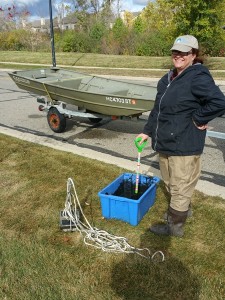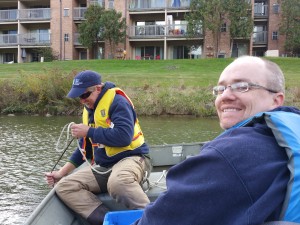
Recently, a team of us HRWC staff went out to see if we could detect the kind of effects scientists from elsewhere are seeing from the application of coal tar sealants. In short, coal tar sealants and their recent cousins release a class of chemicals called polyaromatic hydrocarbons (PAHs), some of which are toxic and known to cause cancer. For more detail on that work see a previous blog entry and our web page summarizing the threats.
To find out if this is indeed a concern in our area, we identified a few detention ponds to sample within the Huron’s biggest urban area of Ann Arbor. The City of Ann Arbor staff helped us find publicly accessible ponds that would capture runoff predominantly from urban areas with lots of hardened surfaces like parking lots and driveways. The city does not use coal tar sealants on its roads, but many businesses use it on parking lots and residents use it on driveways. We selected three ponds from different parts of the city to sample in a pilot effort to determine the level of PAH contamination of pond sediments. Ponds were selected from within the Malletts, Traver and Fleming Creek watersheds.

Sampling these ponds is more difficult than it sounds. It required borrowing a row boat from our friends in the Eastern Michigan University Biology Department, hauling the boat through heavy brush and up steep hills, and rowing out through shallow, mucky waters where we dropped a ponar (i.e. sediment scooper) to grab 5 samples of the bottom sediment. These samples were combined into a single sample for each pond that was then sent to a private lab (with the help of Ann Arbor’s Water Treatment Laboratory staff) for PAH identification and quantification.
The results were shocking. Of the ten PAH samples with identified toxic effects levels, sediments from the Malletts Creek pond exceeded the “probable effects concentration” (PEC) for eight of them! This is the concentration of PAHs in the water that will have adverse affects to aquatic organisms. Sediments in the Traver and Fleming ponds exceeded the PEC for 6 and 4 of the PAH species, respectively. For many of the PAH samples, the PEC was exceeded by 10- or even 100-fold, indicating that the sediments are highly toxic!
Since other studies have indicated that between 50 and 70% of PAHs in detention pond sediments originate from coal tar sealants, it appears that Ann Arbor (and most probably other urban areas in the watershed) has a problem with coal tar leaching. While we only sampled three ponds thus far (we plan to sample others this spring), the results are consistent with findings from research scientists elsewhere.
So, what do we do now? HRWC is currently working with local municipal leaders in Van Buren and Scio Townships, the City of Ann Arbor and elsewhere to pass ordinances to ban the application of coal tar sealants. A state ban would be even more effective but we need to build the political will. Contact HRWC staff to find out how to get involved in your community, and check out the links above to learn what to do on your own driveway.



